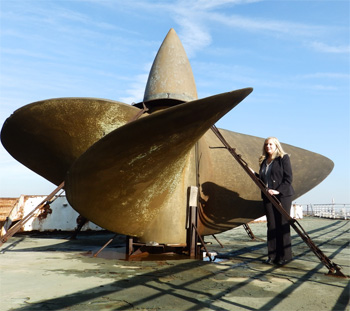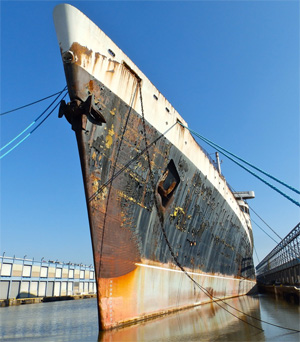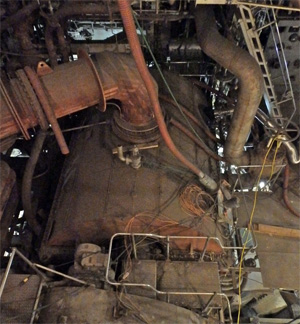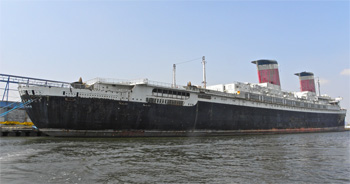Preservationists who own the nation’s flagship liner SS United States have begun a project that will make the weather-beaten vessel more attractive to redevelopers and raise money to pay docking costs.
A 50,000-square-foot area deep in the bowels of the Big U’s hull is being cleared out to provide space for a modern physical plant and wiring. The SS United States Conservancy, which has owned the ship since 2011, hopes the work boosts the possibility that someone will transform it into a mixed-use dockside attraction.
 |
|
SS United States Conservancy board member Susan Caccavale visits one of the ship’s manganese-bronze propellers, now displayed on deck. Caccavale’s mother, Elaine Kaplan, was lead designer of the propellers, which are 18 feet in diameter. |
The sale of scrap metal from the “predevelopment” effort at Philadelphia’s Pier 82 will help the conservancy fund its continued stewardship of SS United States. It costs the nonprofit membership group about $50,000 a month for pier rental, insurance, maintenance and supplies, said Thomas Basile, a consultant to the conservancy.
“Large condenser tanks below the engine room are being removed to make way for more modern electrical and engineering equipment. … Nonferrous metals from that area of the ship are being recycled and are producing income,” Basile said.
“It is revenue-positive and is helping us to maintain the ship as we advance redevelopment plans,” he said.
The preservationists believe the best chance for SS United States to survive would be a 500,000-square-foot development involving hotel, restaurant, retail and performance space. An onboard museum would highlight the history of the nation’s greatest passenger liner. New York, the ship’s home port for 17 years, is the conservancy’s preferred location. It has been laid up at Philadelphia since 1996.
While portions of the Big U’s innards are being sold off, the conservancy is adamant that the original engine-room equipment should be retained as part of the museum. The 990-foot liner still holds the westbound trans-Atlantic passenger-vessel speed record it set in 1952 — three days, 12 hours, 12 minutes. Average speed was 34.5 knots.
 |
|
The ship’s sleek bow helped it set trans-Atlantic speed records. |
The achievement was made possible by four Westinghouse double-reduction geared steam turbines and eight Babcock & Wilcox boilers. Total generation was 247,785 hp.
“The main components of the main engine room will be preserved because it’s the heart and soul of the vessel and its claim to fame,” said Susan Gibbs, the conservancy’s executive director and granddaughter of the ship’s designer, William Francis Gibbs.
During a press tour in January, conservancy officials showed visitors the ship’s interior, now mostly empty. Among the last remaining fixtures are two aluminum bars in the passenger lounge area. In the theater, an empty stage is all that’s left.
“This is the stage where Duke Ellington played on a trans-Atlantic crossing, and this is where Princess Grace and Prince Rainier would sit and sip cocktails,” Basile said.
 |
|
The port forward engine, and three others, are still inside SS United States. Conservators hope to create an onboard museum that will allow visitors to view the Westinghouse double-reduction geared steam turbines. |
Built at Newport News Shipbuilding, SS United States featured many state-of-the-art advancements when it launched in 1951. Aside from its unprecedented propulsion engineering, the ship contained early applications ranging from tempered glass to light dimmers to marine fireproofing. More aluminum was used for the ship than for any previous construction project in history. That’s because it was conceived to do double-duty as the speediest military troop carrier ever, so it needed to be lightweight.
The ship is “tremendously important” to the history of American industry, said conservancy board member Susan Caccavale. Her mother, Elaine Kaplan, a mathematician and nautical mechanical engineer, designed the Big U’s four- and five-blade propellers. Caccavale said future generations of Americans need to be able see the shipbuilding achievement firsthand by visiting the vessel.
“It’s vital that we preserve her,” Caccavale said. “She was the symbol of American innovation and technology that could be extended to other benefits.”

